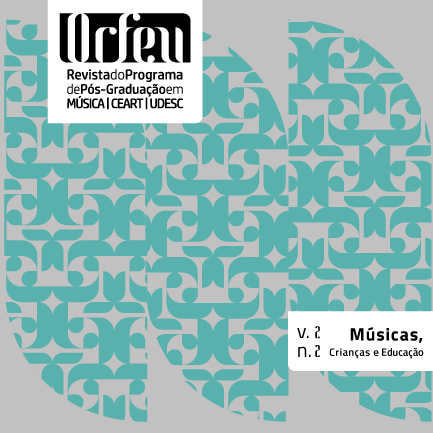Communicative musicality and sense of self
DOI:
https://doi.org/10.5965/2525530402022017133Keywords:
Communicative musicality, Sense of self, Intersubjective processesAbstract
This article presents a theoretical study about the following concepts: communicative musicality as proposed by Malloch (1999) and Malloch and Trevarthen (2009), and the sense of self put forward by Daniel Stern (1992-2000), with a purpose of further understanding the nature of human beings’ relations with music. The strategy herein consists of establishing a conversation with a few researchers and articulating their ideas in order to understand the theme proposed. The conclusion asserts that intersubjective relations form a common point that expresses both concepts. In communicative musicality, intersubjective relations are responsible for the emotional structure that guarantees shared musical experience; in forming the sense of self and its counterpart self with others, intersubjective relations create learning possibilities, including that of a musical sense of self or musical identity.
Downloads
References
BARRETT, Margaret. Attending to “culture in the small”: A narrative analysis of the role of play, thought and music in young children’s world-making. Research Studies in Music Education, v. 38, n. 1, p. 41-54, 2016.
BEEBE, B.; ALSON, D.; JAFFE, J.; FELDSTEIN, S.; CROWN, C. Vocal Congruence in Mother-Infant Play. Journal of Psycholinguistic Research, v. 17, n. 3, p. 245-259, 1988.
DISSANAYAKE, Ellen. Ethology, interpersonal neurobiology, and play. Insights into the evolutionary origin of the arts. American Journal of Play, v.9, n. 2, p.143-168, 2017.
______. Antecedents of the temporal arts in early mother-infant interaction. In: NILS, L. Wallim; MERKER, Björn; BROWN, Steven (Eds.). The Origins of Music. Cambridge, MA: MIT Press, 2001. p. 389-410.
______. The earliest narratives were musical. Research Studies in Music Education, v. 34, n. 1, p. 3-14, 2012.
FERNALD, Anne; SIMON, Thomas. Expanded intonation contours in mothers' speech to newborns. Developmental Psychology, v. 20, n. 1, p. 104-113, 1984.
FERNALD, Anne. Four-month-old infants prefer to listen to “motherese”. Infant Behavior Development, v. 8, p. 181-195, 1985.
HARGREAVES, D. J.; MACDONALD, R.; MIELL, D. Musical identities mediate musical development. In: MCPHERSON, G & WELCH, G. (Eds.). Oxford Handbook of Music Education. V. 1. Oxford: Oxford University Press, 2012. p. 125-142.
IMBERTY, Michel. Narrative, splintered temporalities and the unconscious in 20th century music. Musicae Scientiae, Special Issue, p. 129-146, 2008.
KIRSCHNER, S.; TOMASELLO, M. Joint music making promotes prosocial behavior in 4-year-old children. Evolution and Human Behavior, v. 31, p. 354-364, 2010.
MALLOCH, S.; TREVARTHEN, C. (Eds.). Communicative musicality: Exploring the basis of human companionship. Oxford, UK: Oxford University Press, 2009.
MALLOCH, S. Mothers and infants and communicative musicality. Musicae Scientiae, Special Issue, p. 29-57, 1999-2000.
MAFFIOLETTI, L. A. Aprendizagens sociais propiciadas pela música na infância. In: SANTIAGO, D.; BROOCK, A.; CARVALHO, T. (Orgs.). Educação Musical Infantil. Salvador: PPGMUS-UFBA, 2011. p. 60-73.
MAFFIOLETTI, Leda de A. A música e as primeiras aprendizagens da criança. In: FLORES, Maria Luiza Rodrigues e ALBUQUERQUE, Simone (Orgs.). A implementação do PROINFÂNCIA no Rio Grande do Sul. Perspectivas politicas e pedagógicas. Porto Alegre: EdiPUCRS, 2014. p. 119-126. Disponível em: <http://ebooks.pucrs.br/edipucrs/Ebooks/Pdf/978-85-397-0663-1.pdf>.
PAPAUŠEK, Hanuš. Musicality in infancy research: Biological and cultural origins of early musicality. In: DELIÈGE, I.; SLOBODA, J. (Eds). Musical Beginnings. Origins and development of musical competence. 2. ed. Oxford: Oxford University Press, 2000. p. 37-55.
STERN, Daniel. Diário de um bebê. O que seu filho vê, sente e vivencia. Tradução Daise Batista. Porto Alegre: Artes Médicas, 1991.
STERN, Daniel. Forms of Vitality. Exploring dynamic experience in psychology, the arts, psychotherapy, and development. Oxford: Oxford University Press, 2010.
STERN, Daniel. O momento presente na psicoterapia e na vida cotidiana. Tradução Celimar de Oliveira Lima. Rio de Janeiro: Record, 2007.
STERN, Daniel. Putting time back into our considerations of infant experience: a microdiachronic view. Infant mental health journal, v. 21, n. 1-2, p. 21-28, 2000.
STERN, Daniel. O mundo interpessoal do bebê. Uma visão a partir da psicanálise e da psicologia do desenvolvimento. Tradução Maria Adriana Veríssimo Veronese. Porto Alegre: Artmed, 1992.
STILL face experiment. Dr. Edward Tronick. Vídeo. Duração: 2’49”.
Infant-Parent Mental Health Program. ZERO TO THREE.
Disponível em: <https://www.youtube.com/watch?v=apzXGEbZht0&t=9s>.
Acesso em: 23 set. 2017.
TREVARTHEN, C.; DELAFIELD-BUTT, J. T. Intersubjectivity in the imagination and feelings of the infant: Implications for education in the early years. In: WHITE, Jaine; DALLI, Carmen (Eds.). Under-three year olds in policy and practice. New York: Springer, 2017. p. 17-40.
TREVARTHEN, C.; AITKEN, K. Infant Intersubjetivity, research theory, and clinical application. Journal of child psychology and psychiatry, v. 42, n. 1, p. 3-48, 2001.
Downloads
Published
How to Cite
Issue
Section
License
Copyright (c) 2017 ORFEU

This work is licensed under a Creative Commons Attribution 4.0 International License.
Authors who submit their manuscripts to be published in this journal agree to the following terms:
1. Authors retain the copyright and grant to the journal the right of first publication, whilst simultaneously permitting their work to be licensed under the Creative Commons License Attribution, which allows the sharing of work with recognition of the authorship and initial publication in this journal.
2. Contributions in this journal are open access; this means they are based in free use, and non-commercial applications.






